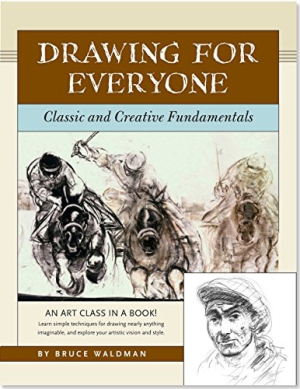Drawing for Everyone
Classic and Creative Fundamentals
Bruce Waldman distills the essence of his art experience into his thorough guide to drawing.
Perhaps the most important credential for anyone teaching art is experience, both in and out of the classroom. Waldman has both in spades, having served as an adjunct professor at New York’s School of Visual Arts for over thirty years, and as the recipient of awards and accolades for his own illustrations. His professional and pedagogical experience means that Waldman can vouch for what works and what is less effective, what’s important and what’s not, in drawing. It’s this succinct, thorough, but not overwhelming style that makes Drawing for Everyone live up to its title: beginners will be able to follow these lessons, practicing their own drawings or just gaining a better understanding of art and appreciation of it; longtime artists will benefit from the subtleties of Waldman’s examples and theory.
The book’s subtitle, “An Art Class in a Book,” is accurate; readers get the “feel” of an art class due to Waldman’s friendly tone and interesting asides about his personal experiences and drawing tips. One of the concepts Waldman discusses is that of composition and balance in drawings, and it’s this model that carries over to the overall structure of the book. Clearly arranged into thirteen chapters, the book covers the basic rules of drawing, light and shadow, perspective, faces, people, and animals, with each chapter a perfectly composed balance of examples, tips, theory, and suggestions to push beyond the basics and draw upon one’s own creativity.
Waldman’s voice is not that of an artist mired in the past, either—for example, he refers to the use of 3-point perspective in the film The Matrix and suggests studying the facial expressions of comic book characters like Wolverine. These modern references help to create a less intimidating environment, especially for beginners. As presented here, even the simplest drawings are seen as part of a single continuum, along with the works of Da Vinci and Rembrandt. Further, techniques featured in modern visual entertainment are traced back to concepts originated by the old masters.
Plumb lines, perspective, and other concepts are all clearly conveyed, and Waldman’s own artwork provides inspiration throughout the book. With many “how to draw” books published every year, Drawing for Everyone stands out as one of the very few that could earn a place on the bookshelves of artists and nonartists alike as “essential.”
Reviewed by
Peter Dabbene
Disclosure: This article is not an endorsement, but a review. The publisher of this book provided free copies of the book to have their book reviewed by a professional reviewer. No fee was paid by the publisher for this review. Foreword Reviews only recommends books that we love. Foreword Magazine, Inc. is disclosing this in accordance with the Federal Trade Commission’s 16 CFR, Part 255.

